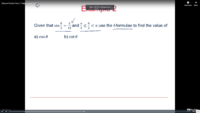You are using an out of date browser. It may not display this or other websites correctly.
You should upgrade or use an alternative browser.
You should upgrade or use an alternative browser.
T formulae Q
- Thread starter Sonal7
- Start date
\(\displaystyle \cos\left(\dfrac \theta 2\right)\) isn't necessarily \(\displaystyle -\dfrac{13}{12}\)
\(\displaystyle \theta = 45.24^\circ \Rightarrow \sin\left(\dfrac \theta 2\right) \approx \dfrac{5}{13} \text{ and }\cos\left(\dfrac \theta 2\right) \approx \dfrac{12}{13}\)
To get the numbers you wrote \(\displaystyle \dfrac \theta 2\) must be in the 2nd quadrant, where sines are positive, and cosines are negative.
\(\displaystyle \dfrac \theta 2 = \pi - \arcsin\left(\dfrac{5}{13}\right) \approx 157.38^\circ \Rightarrow \theta \approx 314.76^\circ\)
with this value of \(\displaystyle \theta\) we obtain the values for sine and cosine you want.
\(\displaystyle \theta = 45.24^\circ \Rightarrow \sin\left(\dfrac \theta 2\right) \approx \dfrac{5}{13} \text{ and }\cos\left(\dfrac \theta 2\right) \approx \dfrac{12}{13}\)
To get the numbers you wrote \(\displaystyle \dfrac \theta 2\) must be in the 2nd quadrant, where sines are positive, and cosines are negative.
\(\displaystyle \dfrac \theta 2 = \pi - \arcsin\left(\dfrac{5}{13}\right) \approx 157.38^\circ \Rightarrow \theta \approx 314.76^\circ\)
with this value of \(\displaystyle \theta\) we obtain the values for sine and cosine you want.
Dr.Peterson
Elite Member
- Joined
- Nov 12, 2017
- Messages
- 16,604
Please show the whole problem and your work. If you used the half-angle formula, you should know that there is a plus-or-minus in it, which must be filled in based on other information. If you were just given [MATH]\sin\frac{\theta}{2}[/MATH], then you can't know the sign of the cosine.Sin (theta/2) is 5/13, and thus it transpires that cos (theta/2) is -13/12. I am wondering why its negative, I know about cast diagram but I cant visualise why cos is negative. Its a very basic q but I cant see it this time.
Dr.Peterson
Elite Member
- Joined
- Nov 12, 2017
- Messages
- 16,604
Right. The quadrant determines the sign.
I am not familiar with the term "t-formula", which is not very descriptive, but on looking it up I see how you are using it.
I am not familiar with the term "t-formula", which is not very descriptive, but on looking it up I see how you are using it.
pka
Elite Member
- Joined
- Jan 29, 2005
- Messages
- 11,974
@Sonal7, If you are doing trigonometry, then you should know that \(\displaystyle (\forall x)[-1\le\cos(x)\le 1]\) hence \(\displaystyle (\forall x)\left[\cos(x)\ne-\frac{13}{12}\right]\) Do you see why?Sin (theta/2) is 5/13, and thus it transpires that cos (theta/2) is -13/12. I am wondering why its negative, I know about cast diagram but I cant visualise why cos is negative. Its a very basic q but I cant see it this time.

